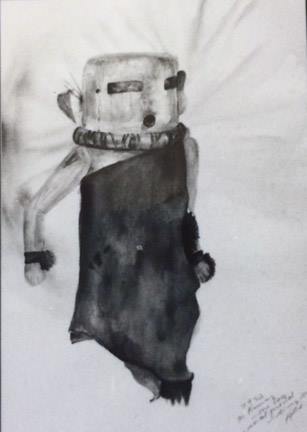Write What You Know
From the time my love affair with books began I have contemplated books, authors and the business of publishing. At age twenty I landed my first bookselling job at a Waldenbooks in the Glendale Galleria (in a suburb of Los Angeles). There I worked with a woman I greatly admired, a graduate student who is now head of the Comparative Literature Department at Cornell University, and tried to absorb everything she offered. She was exotic, studying abroad in Egypt, and I wanted to be just like her. But I wasn’t like her, and never could be. She had fully grasped her passion; mine was still waiting to find me.
Some months later I found myself in another Waldenbooks in another city, this time in Sacramento. And a year later I was preparing to move back to Tucson when one of my co-workers, an art student at the university, bestowed me with a life-changing gift. Since I was returning to the southwest, she thought one of her unfinished paintings of a kachina doll would be a fitting going-away gift. 
Now only a black-and-white photo memory preserved in a scrapbook, back then I was so enthralled by the gift of original art that I went to the time and expense to have it framed and hung it proudly in my room. Yet a single piece of art looks lonely without companions, so I started buying inexpensive Southwest Indian pottery items for decorative purposes. This led to a curiosity of the people that made those items and a desire to collect something from every pottery-making tribe in the southwest. Which led to studies of those cultures and American Indian history… where I discovered prehistoric southwest cultures…which led to…well, my passion had snuck up on me.
Shortly after I was hired in 1987 by The Haunted Bookshop in Tucson I was well enough versed in western history and American Indian literature to be put in charge of the southwest section of the store. I read voraciously during my tenure, eventually becoming brave enough to write the occasional book review for a local periodical The Desert Leaf. Before Haunted closed in 1997 I had been accepted by Publishers Weekly as a reviewer of books on American Indian and western history topics. What a cool, and challenging, gig!
Gradually I realized anyone could publish a book—that it didn’t take an advanced degree and superhuman powers—a seed was planted of one day joining the community of authors. The old adage goes, “write what you know,” and the one thing I did know well was American Indian art. Yet my first contacts with publishers were fraught with disappointment and failure, but those are other stories for other times.
The book Navajo Spoons: Indian Artistry and the Souvenir Trade, 1880s-1940s published in 2001 boosted my resolve. The author wasn’t an academic, an anthropologist, nor (discovered during a happenstance meeting) particularly knowledgeable about American Indian art. Yet she published an informative, professional book put out by the Museum of New Mexico Press, one of the most respected southwestern publishing houses. With the success of a book so focused on one small aspect of Indian art—spoons made by Navajo silversmiths—I was sure we could accomplish something that would interest a publisher. But on which topic?
By the late 1990s Pat and I had gone through many phases in our collecting careers, from novices with small budgets, to more knowledgeable and selective buyers building collections that told stories. Pat focused on Hopi and Pueblo made pottery tiles, while I was fascinated with anything Hopi, particularly the silver jewelry made by early silversmiths who left the mesas to work in curio shops in the cities.
Long story short – in the summer of 2007 Pat and I joined the ranks of published authors as Rio Nuevo Publishers released  Hopi & Pueblo Tiles: An Illustrated History. We promoted the heck out of it and managed to sell nearly 1700 copies in the first six months of release. As of February 2014 Rio Nuevo counted only 172 copies remaining in their inventory and our royalty statements showed 2690 copies sold by the end of 2013.
Hopi & Pueblo Tiles: An Illustrated History. We promoted the heck out of it and managed to sell nearly 1700 copies in the first six months of release. As of February 2014 Rio Nuevo counted only 172 copies remaining in their inventory and our royalty statements showed 2690 copies sold by the end of 2013.
But the end result was not easily accomplished and we devoted many hours, and called in a few favors, to make it happen. It’s not an easy journey and publishing is perhaps the singularly most frustrating experience a person could voluntarily take part in. Getting to the end with a finished book in hand is a minor miracle.
One thing we learned along the way is that our books have a determined and precise audience, and that our best promotional opportunities are at Indian art shows and galleries in Santa Fe in the summer and during the winter months in Southern Arizona. And more and more social media is where we find the best promotional opportunities.



